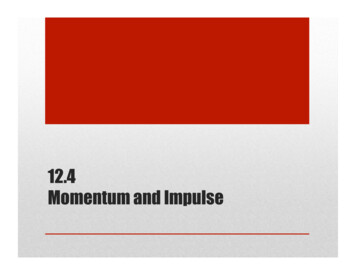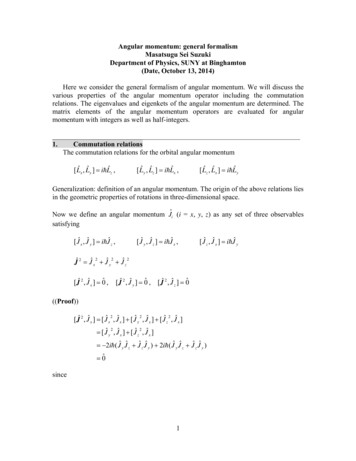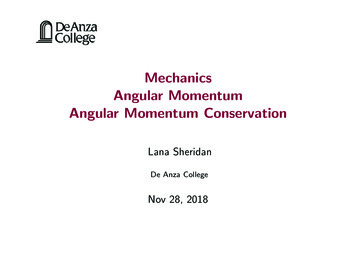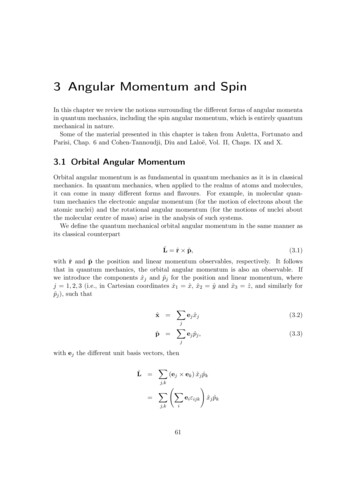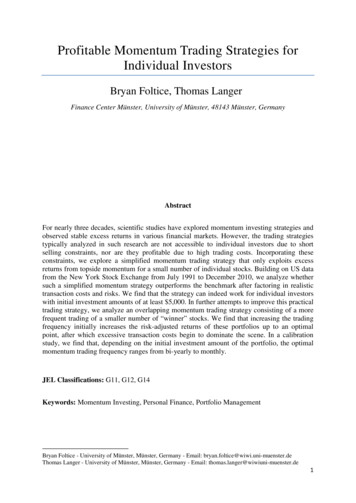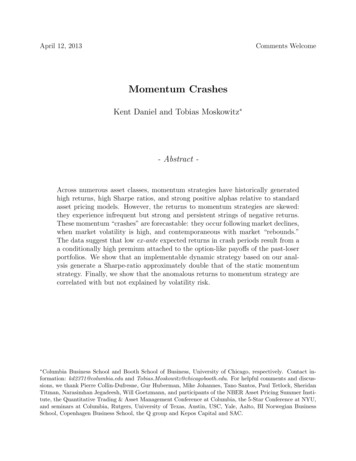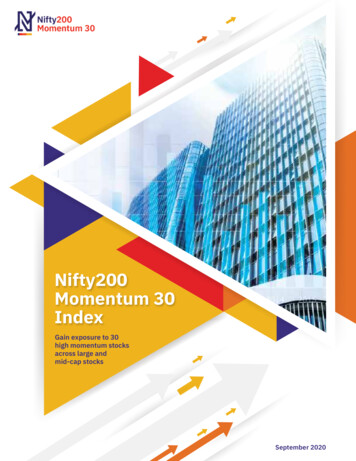
Transcription
Is momentum really momentum? Robert Novy-Marx AbstractMomentum is primarily driven by firms’ performance 12 to seven months prior toportfolio formation, not by a tendency of rising and falling stocks to keep rising andfalling. Strategies based on recent past performance generate positive returns but areless profitable than those based on intermediate horizon past performance, especiallyamong the largest, most liquid stocks. These facts are not particular to the momentumobserved in the cross section of US equities. Similar results hold for momentumstrategies trading international equity indices, commodities, and currencies.Keywords: Momentum, factor models.JEL Classification: G12. I thank Gene Fama, Andrea Frazzini, Hanno Lustig, Toby Moskowitz, Milena Novy-Marx, and theanonymous referee. Simon School of Business, University of Rochester, 5807 S Woodlawn Avenue, Chicago, IL 60637.Email: robert.novy-marx@simon.rochester.edu.
1. IntroductionMomentum, the tendency of an object in motion to stay in motion, does not accuratelydescribe the returns to buying winners and selling losers. The stocks that have risen themost over the past six months, but performed poorly over the first half of the preceding year,significantly under-perform those stocks that have fallen the most over the past six monthsbut performed strongly over the first half of the preceding year. That is, intermediatehorizon past performance, measured over the period from 12 to seven months prior, seemsto better predict average returns than does recent past performance. This fact is difficultto reconcile with the traditional view of momentum, that rising stocks tend to keep rising,while falling stocks tend to keep falling, i.e., a short run autocorrelation in prices.The fact that intermediate horizon past performance has more power than recent pastperformance predicting returns can be seen in a variety of ways. In Fama-MacBethregressions of stocks’ returns on their past performance, the coefficient on intermediatepast performance is significantly higher than that on recent past performance. Momentumtrading strategies based on intermediate past performance generate larger, more significantreturns than those based on recent past performance and have significant alphas relative tothe Fama-French four factor model, while the strategies based on recent past performancedo not. Portfolios double sorted on recent and intermediate horizon past performanceexhibit roughly twice the variation in returns across the intermediate past performancedimension as they do in the recent past performance dimension.Moreover, while the predictive power of recent returns seems to have diminishedover time, that of intermediate past returns has not. Strategies based on recent pastperformance were exceptionally profitable in the 1950s and 1960s, but have not performedas well since. Strategies based on intermediate horizon past performance have performed1
consistently over time and, if anything, have been more profitable over the last 40 years.This divergence in performance also has been accompanied by an increased correlationon the strategies’ returns. Because recent return strategies covary significantly with anintermediate past return factor, even when they are explicitly constructed to be intermediatepast return neutral, over the last several decades the recent return strategies contribute littleto the opportunity set of an investor already trading the three Fama-French factors andintermediate horizon momentum.These results are not particular to the momentum observed in the cross section of USequities. Similar results hold for momentum strategies constructed in other asset classes.Momentum strategies that trade industries, investment styles, international equity indices,commodities, and currencies all exhibit the same phenomena. The Sharpe ratios of thestrategies based on intermediate horizon past performance are more than twice as largeas the Sharpe ratios of the strategies based on recent past performance. The strategiesbased on intermediate horizon past performance also all have large, highly significantinformation ratios relative to the strategies based on recent past performance. The strategiesbased on recent past performance never generate significant abnormal returns relative to thestrategies based on intermediate horizon past performance.Practically, the recognition that the abnormal returns to buying winners and sellinglosers derives primarily from intermediate horizon, not recent, past performance aids inthe construction of more profitable strategies. This is especially true among the largest,most liquid stocks, which exhibit more momentum than is commonly recognized. Thevalue-weighted strategy, restricted to large stocks (largest quintile by market equity usingNew York Stock Exchange break points, made up of roughly the three hundred largestfirms in the economy), which buys (sells) the top (bottom) quintile of performers overthe period 12 to seven months prior to portfolio formation, generated average returns ofalmost 10% per year from January 1927 through December 2008. The fact that Fortune 5002
companies exhibit strong momentum suggests that properly designed momentum strategiesare profitable on a greater scale than that estimated by Korajczyk and Sadka (2004) and thatthe trading cost critique of Lesmonda, Schill, and Zhou (2004) is significantly overstated.Theoretically, the return predictability implied by the data, which looks more likean echo than momentum, poses a significant difficulty for stories that purport to explainmomentum. None of the popular explanations, either behavioral (e.g., Barberis, Shleiferand Vishny, 1998, Hong and Stein, 1999, and Daniel, Hirshleifer and Subrahmanyam,1999) or rational (e.g., Johnson, 2002, and Sagi and Seasholes, 2007), delivers the observedterm structure of momentum information, which exhibits significant information in pastperformance at horizons of 12 to seven months, recent returns that are largely irrelevantafter controlling for performance at intermediate horizons, and the abrupt drop-off at 12months, beyond which there is no return predictability after controlling for value.My primary result– that intermediate horizon past performance, not recent pastperformance, drives momentum– cannot be explained by any known results. It is notexplained by the 12 month effect identified by Jegadeesh (1990) and studied in detailby Heston and Sadka (2008). It is robust to controlling for earnings momentum, whichexplains short horizon momentum but not intermediate horizon momentum. It cannot beexplained by capital gains overhang or disposition effects. It is essentially unrelated to theconsistency of performance result of Grinblatt and Moskowitz (2004).The remainder of the paper is organized as follows.Section 2 shows that theprofitability of momentum strategies derives primarily from intermediate horizon pastperformance, not recent past performance. Section 3 shows this formally. In particular,it shows that the coefficient on intermediate past performance significantly exceeds thaton recent past performance in Fama-MacBeth regressions of firms’ returns; momentumstrategies based on intermediate horizon past performance are more profitable than thosebased on recent past performance, and have significant information ratios relative to the3
Fama-French four-factor model while those based on recent past performance do not;and double sorting on both intermediate horizon and recent past performance yieldssubstantially larger returns spreads along the intermediate horizon dimension. Section 4shows that the disparity in the power of intermediate horizon and recent past performanceto predict returns is especially acute among large, liquid stocks. Section 5 shows thatthese results also hold for momentum strategies that trade other asset classes, includingindustries, investment styles, international equity indices, commodities, and currencies.Section 6 places my primary result in the context of the literature and demonstrates itsrobustness. Section 7 concludes.2. The term-structure of momentumPrevious research has devoted significant attention to the length of the test periodover which past performance is evaluated when constructing momentum portfolios.For example, Jegadeesh and Titman (1993) consider the “J K-strategies,” which formportfolios based on stock performance over the previous J months (excluding the last weekor month prior to portfolio formation, to remove the large short-horizon reversals associatedwith bid-ask bounce) and hold the portfolios for K months, where J; K 2 f3; 6; 9; 12g.Almost no attention has been devoted, however, to how long before portfolio formationthis test period should end. This gap reflects, perhaps, the presumption that the returnsto buying winners and selling losers was due to momentum, short-run autocorrelation instock returns, and that the power of past returns to predict future returns therefore decaysmonotonically over time. In this section I show that this assumption is false, by consideringthe returns to momentum strategies while varying the length of the test period and the timebetween the test period and portfolio formation. I fix the holding period at one month tokeep the number of strategies under consideration manageable.4
2.1. Data and portfolio constructionThe data cover the sample period from January 1926 through December 2008 andinclude all stocks in the Center for Research in Securities Prices (CRSP) universe. TheFama-French up-minus-down factor (UMD) replicated in this data generates a monthlyreturn series more than 99% correlated with the series posted on Ken French’s y/ken.french/data library.html).Momentum strategies are constructed each month by buying winners and selling losers,where these are defined as the upper and lower decile, by NYSE breaks, of cumulativereturns over a test period. The n-m strategy is based on portfolios sorted on rn;m , denotingcumulative returns from n to m months (inclusive) prior to portfolio formation. The n-mstrategy and its return series are both denoted MOMn;m . I consider value-weighted andequal-weighted strategy returns. I construct strategies using all available data, employingreturns beginning in January 1926.2.2. Strategies based on past performance in a single monthFig. 1 shows the performance of strategies formed on the basis of performance in asingle month, i.e., of winner-minus-loser portfolios where winners and losers are definedas the top and bottom decile of performance, respectively, in the month lag prior to portfolioformation. Strategies are formed using a single month’s returns realized from one month to15 months prior to portfolio formation. The figure depicts these strategies’ average monthlyreturns, monthly standard deviations, and realized annual Sharpe ratios. Value-weightedresults appear as black bars, and equal-weighted results are depicted as grey bars.Panel A shows strategies’ monthly average returns. The general trend is upward slopingspreads, i.e., spreads that increase with time between performance evaluation and portfolioformation, which fall off a cliff after 12 months. This profile is largely consistent with5
PerformancePanel B: MOMlag,lagMonthly standard deviaton (percent)Monthly average retuns (percent)lag,lag0.80.60.40.20 0.2 0.4 0.61 2 3 4 5 6 7 8 9 101112131415LagPanel C: MOMVolatilitylag,lagSharpe ratio0.65.5Sharpe ratio (annualized)Panel A: MOM54.543.50.40.20 0.2 0.431 2 3 4 5 6 7 8 9 101112131415Lag1 2 3 4 5 6 7 8 9 101112131415LagFig.1. Marginal strategy performance. This figures shows the average monthly returns (Panel A),monthly standard deviations (Panel B) and annual Sharpe ratio (Panel C) to winners-minus-losersstrategies. Winners and losers are defined as the top and bottom deciles of performance in asingle month, respectively, starting lag months prior to portfolio formation. Dark bars showvalue-weighted results and light bars show equal-weighted results. Average monthly returns forthe one month reversals are -0.98% (value-weighted) and -2.92% (equal-weighted). The samplecovers April 1927 to December 2008.the Heston and Sadka (2008) estimate, from Fama-MacBeth regressions, of the slopecoefficient of past performance on expected returns as a function of historical lag. Theupward sloping term-structure is inconsistent with the common conception of momentumas a short-run autocorrelation in returns. The abrupt drop-off after one year is one of themost striking features of the figure and poses a significant hurdle for stories, either rationalor behavioral, that attempt to explain momentum.Panel B depicts the standard deviation of the strategies’ monthly returns. It shows agenerally downward sloping relation between the time between performance evaluationand portfolio formation and a strategy’s volatility. The observed pattern is consistent withmean-reverting stochastic volatility. The portfolio selection criteria, which select for stocksthat have experienced large movements, bias both the winner and loser portfolios towardstocks that have high volatility and, consequently, toward stocks that have volatilities higherthan their own long-run average. A longer interval prior to portfolio formation providestime for these volatilities to revert downward.6
Panel C shows the strategies’ Sharpe ratios. The pattern here is largely inherited fromthe return spreads, tilted counterclockwise by the downward sloping volatility profile. Thatis, the term-structure of performance slopes up even more steeply than the term-structureof expected returns. The figure consequently suggests that the months closest to portfolioformation contribute little to the performance of the typical momentum strategy.2.3. Portfolios sorted on recent and intermediate past performanceFig. 1 suggests that past performance at intermediate horizons contributes more to theprofitability of momentum strategies than does past performance at recent horizons. Thesimplest way to test this hypothesis is to compare the profitability of strategies formed onthe basis of recent and intermediate horizon past performance. Recent and intermediatehorizons are defined here simply as the near and distant halves of the performanceevaluation period most commonly employed in the construction of momentum strategies,i.e., using the past performance metrics r6;2 and r12;7 , respectively.Fig. 2 depicts results of forming portfolios on the basis of intermediate horizon or recentpast performance. Each line in the figure shows the average monthly returns to a continuumof quintile-like portfolios, constructed by sorting on r12;7 and r6;2 (solid and dashed lines,respectively). Each point in the past performance distribution corresponds to a portfoliothat holds stocks in Gaussian proportions, where the Gaussian is centered at the point,and has a bandwidth (standard deviation) of 10%. Each portfolio’s holdings are thereforeconcentrated in a 20% range of the past performance distribution and, consequently,behave much like a quintile portfolio. Panel A shows value-weighted results, where theweights correspond to the fraction of firms’ market capitalizations held in the portfolio.Panel B shows equal-weighted results, where the weights correspond to dollar valuesheld in the portfolio. Returns are shown either in excess of the average market return(value-weighted results) or in excess of the average stock’s average return (equal-weighted7
Panel B: equal weighted results0.6Average returns (percent per month)Average returns (percent per month)Panel A: value weighted results0.40.20 0.2 0.4 0.6020406080Past performance percentile1000.60.40.20 0.2 0.4 0.6020406080Past performance percentile100Figure 2. Average returns to portfolios sorted on r12;7 and r6;2 . This figure shows averagemonthly returns to portfolios sorted on intermediate horizon past performance (solid line) andrecent past performance (dashed line), in excess of the average stock’s returns. For each point inthe past performance distribution, stocks are held in Gaussian proportions, centered at the point inquestion, with a standard deviation of 10%. Portfolios are constructed each month. Panel A showsvalue-weighted results, where the weights represent the fractions of firms’ market capitalizationsheld in the portfolio. Panel B shows equal-weighted results, where the weights correspond to dollarvalues held in the portfolio. The sample period covers January 1927 through December 2008.results). Portfolios are constructed each month, and the sample period covers January 1927through December 2008.The figure shows a substantially stronger relation between intermediate pastperformance and expected returns than between recent past performance and expectedreturns. The relation between intermediate horizon past performance and average returns isstrong, and roughly linear, while the relation between recent past performance and averagereturns is both weaker and concentrated in the tails of the distribution.The figure seems to contradict the Hong, Lim, and Stein (2000) contention that thebulk of momentum profits come from the short side. Hong, Lim, and Stein argue thata momentum strategy’s profitability is driven by losers’ under-performance, and not bywinners’ out-performance. The figure suggests that both sides contribute roughly equally8
to a momentum strategy’s profitability.3. Information in intermediate horizon past performanceFig. 2 suggests that momentum derives primarily from past performance at intermediatehorizons, not recent past performance. This section investigates this hypothesis formally.3.1. Parametric resultsTable 1 reports results of Fama-MacBeth regressions of returns on recent andintermediate horizon past performances, r6;2 and r12;7 , and controls for past month’sperformance, size, and book-to-market.1The first column shows results over the entire 82-year sample, spanning January 1927to December 2008. The coefficient in intermediate horizon past performance is nearlytwice that on recent past performance, and the difference is statistically significant. Thedifference is not driven by the fact that the intermediate horizon evaluation period covers sixmonths while the recent past performance covers only five. Defining intermediate horizonpast performance as performance over the first five months of the preceding year yieldsqualitatively identical results.The second two columns show results in the early and late halves of the sample,respectively, January 1927 to December 1967 and January 1968 to December 2008. The1The size control is the log of firms’ market capitalizations, lagged one month. The book-to-marketcontrol is the log of book-to-market, where book-to-market is book equity (shareholder equity, plus deferredtaxes, minus preferred stock) scaled by market equity lagged six months, and is updated at the end of eachJune using accounting data from the fiscal year ending in the previous calendar year. For the componentsof shareholder equity, I employ tiered definitions largely consistent with those used by Fama and French(1993) to construct their high-minus-low factor, HML. Stockholders equity is as given in Compustat (SEQ)if available, or else common equity plus the carrying value of preferred stock (CEQ PSTX) if available, orelse total assets minus total liabilities (AT - LT). Deferred taxes is deferred taxes and investment tax credits(TXDITC) if available, or else deferred taxes and/or investment tax credit (TXDB and/or ITCB). Preferedstock is redemption value (PSTKR) if available, or else liquidating value (PSTKRL) if available, or elsecarrying value (PSTK). Prior to the availability of Compustat, I employ the Davis, Fama and French (2000)book equity data. Independent variables are winsorized at the 1% and 99% levels.9
Table 1.Fama-MacBeth regressions results.This table reports results from Fama-MacBeth regressions of firms’ returns on past performance,measured at horizons 12 to seven months (r12;7 ) and six to two months (r6;2 ). Regressions includecontrols for prior month’s performance (r1;0 ), size (log(ME)), and book-to-market (log(BM)).Independent variables are winsorized each month at the 1% and 99% levels. The sample coversJanuary 1927 to December 2008. The early and late half samples cover January 1927 to December1967 and January 1968 to December 2008, respectively. The quarter samples cover January 1927to June 1947, July 1947 to December 1967, January 1968 to June 1988, and July 1988 to December2008.Slope coefficient ( 102 ) and [test-statistic] fromregressions of the form rtj D ˇ 0 xtj C amplesSecond 6]0.77[2.25]r1;0-7.79[-20.6]-9.50-6.07[-15.8] [-13.6]-12.0[-12.0]-6.99[-11.1]-8.29-3.85[-13.7] [-6.15]log(ME)-0.13[-3.88]-0.16-0.10[-3.08] [-2.36]-0.25[-2.66]-0.07[-1.65]-0.08-0.12[-1.36] ]0.27[0.86]Independentvariabler6;2coefficient estimates on both intermediate horizon and recent past performance are verysimilar in these subsamples to their whole sample counterparts, though they are estimatedmore precisely in the late sample, over which the data are more reliable, more stocks weretraded, and the market was less volatile.The last four columns show results over four equal 20.5-year subsamples.Thecoefficient estimates on intermediate horizon past performance are again stable acrosssubsamples, corresponding closely to the whole sample estimate, and always significant.10
This contrasts sharply with recent past performance, on which the coefficient estimatesvary widely across subsamples. The coefficient on recent past performance is large andnegative, though insignificant, in the prewar sample; extremely large and highly significantfrom mid-1947 to the end of 1967; positive but insignificant from the beginning of 1968 tomid-1988; and significantly positive, though not particularly large, from mid-1988 to theend of 2008.Fig. 3 presents similar, more nuanced results graphically. The figure depicts resultsof rolling ten-year Fama-MacBeth regressions employing the same variables used inthe regressions presented in Table 1. Panel A shows the coefficient estimates on bothintermediate horizon and recent past performance for each ten-year period ending on thecorresponding date. Panel B shows the test-statistics of these coefficient estimates.The figure depicts results consistent with those from Table 1. The coefficient on r12;7is relatively stable over the entire sample, and generally significant. The coefficient onr6;2 , in contrast to that on r12;7 , swings wildly over the sample. While the estimate on r6;2is exceptionally large in the 1950s and 1960s, it is negative from the start of the sample(January 1927) through World War II and frequently close to zero since the inclusion ofNasdaq in CRSP.Taken as a whole, these Fama-MacBeth regressions suggest that intermediate pastreturns have surprisingly strong predictive power, even stronger than the predictive powerof recent returns.Moreover, the predictive power of recent returns seems to havediminished in recent decades, while that of intermediate past returns has not.3.2. Spanning testsNonparametric tests, which analyze the relations between the returns to momentumstrategies formed employing only the early and late information used to construct thestandard strategy, generally support these conclusions drawn from the Fama-MacBeth11
Panel A: Trailing ten year Fama MacBeth slope coefficients on past performance3Slope coefficient (x 100)210 1 2r12,7r 36,21940195019601970198019902000DatePanel B: Trailing ten year Fama MacBeth test statistics on past performance6Test statistic420r12,7r6,2 21940195019601970198019902000DateFigure 3. Ten-year trailing slope coefficients on past performance measures. Panel A showscoefficient estimates from rolling ten-year Fama-MacBeth regressions of returns on intermediatehorizon past performance (r12;7 , solid) and recent past performance (r6;2 , dashed). Regressionsinclude controls for prior month’s performance, size, and book-to-market (r1;0 , ln(ME), and ln(BM),respectively). Panel B shows the test-statistics on these coefficients from the same regressions.12
regressions.These spanning tests regress a test strategy’s returns on the returns to one or moreexplanatory strategies.The intercept’s test-statistic is the information ratio of thetest strategy benchmarked to the mimicking portfolio constructed from the explanatorystrategies.An insignificant intercept suggests the test strategy is inside the span ofthe explanatory strategies. In this case the test strategy does not add significantly tothe investment opportunity set. A high information ratio, i.e., a statistically significantintercept, suggests that adding the test strategy to the investment opportunity set results inan attainable Sharpe ratio that significantly exceeds that which can be achieved with theexplanatory strategies alone.The test strategies I employ in these spanning tests are MOM12;7 and MOM6;2 , whicheach month hold winners and short losers, defined as the upper and lower deciles of r12;7and r6;2 , respectively, using NYSE breaks. I employ the relatively aggressive decile sortbecause Fig. 2 suggests the profitability of momentum strategies based on recent pastperformance derives primarily from the tails of the past performance distribution. Usinga less extreme sort (e.g., quintile or tertile) makes the results presented in this paper evenstronger. Strategy returns are value-weighted. Tests employing equal-weighting strategyreturns yield qualitatively identical results.Table 2 shows basic properties of the two test strategies, MOM12;7 and MOM6;2 , bypresenting results of time series regressions of the two strategies’ returns on the market, thethree Fama-French factors, and the three Fama-French factors plus UMD (up-minus-down).Specifications 1 and 5 show that both strategies generate large, significant average returns.MOM12;7 generates 1.21% per month, while MOM6;2 generates 0.79% per month. Whilethe difference in the two strategies’ returns of 0.43% per month is significant at the10% level, it is not significant at the 5% level (the test-statistic of the difference is1.78). Specifications 2 and 6 show that both strategies garner significantly negative13
Table 2.Momentum strategy factor loadings.This table presents results of time-series regressions employing the returns to momentumstrategies constructed using intermediate horizon and recent past performance. MOMn;m is thereturns of the winner-minus-loser strategy (deciles, employing NYSE breaks), where winners andlosers are based on cumulative returns from n to m months (inclusive) prior to portfolio formation.The sample period covers January 1927 through December 2008.IndependentvariableIntercept(1)Intercept (percent per month) and slope coefficientwith [test-statistic], under alternative specificationsy D MOM12;7y D MOM6;2(2)(3)(4)(5)(6)(7)1.211.36[5.80] [6.58]1.57[8.03]0.43[3.00]0.791.09[3.45] [5.03](8)1.27-0.01[6.17] [-0.10]MKT-0.24 -0.140.07[-6.46] [-3.80] [2.64]-0.51 -0.40 -0.15[-13.3] [-9.96] [-5.60]SMB-0.050.02[-0.79] [0.57]-0.24 -0.16[-3.81] [-3.84]HML-0.62 -0.16[-11.3] [-3.87]-0.450.07[-7.76] [1.67]UMD1.04[30.9]1.17[35.7]Adj. R20.1530.2110.6570.0490.1810.562loadings on the market, similar to those found on conventional 12–2 momentum strategies.Specifications 3 and 7 show that both strategies also have large negative HML loadingsin the three-factor model, which results in extremely large three-factor pricing errors, asituation again similar to that found with conventional momentum. Finally, specifications4 and 8 show that the strategies’ alphas relative to the Fama-French four-factor model aremuch smaller. Including UMD as an explanatory factor reduces the alphas both directly,because the strategies load heavily on UMD, and indirectly, by reducing the magnitudesof the momentum strategies’ negative loadings on HML and MKT (market excess return).Nevertheless, the 12–7 strategy generates significant abnormal returns, 0.43% per month14
with a test statistic of 3.00, relative to the four-factor model. The 6–2 strategies’ abnormalfour-factor returns are completely insignificant.Table 3 presents the average returns of these momentum strategies, MOM12;7 andMOM6;2 , and results from time series regressions on these strategies’ returns on the threeFama-French factors and each other. The first column presents results from the fullsample and shows that both strategies have large information ratios relative to the threeFama-French factors and each other. Panel A shows that the 12–7 strategy’s abnormalreturns relative to the three Fama-French factors and the 6–2 strategy is indistinguishablefrom its average returns over the period, 1.21% per month with a test statistic of 6.36.The bottom panel shows that the 6–2 strategy’s abnormal returns relative to the threeFama-French factors and the 12–7 strategy is similarly essentially indistinguishable fromits average returns over the period, 0.77% per month with a test statistic of 3.81.The next two columns show results for the early and late halves of the data. Theydemonstrate that both strategies were more profitable over the second 41 years of the datathan they were over the first 41 years. The 12–7 strategy yielded 1.45% per month, witha test statistic of 6.23, from January 1968 to December 2008, but only 0.98% per month,with a test statistic of 2.82, from January 1927 to December 1967, while the 6–2 strategygenerated 1.06% per month, with a test statistic of 4.01, over the late sample, but only aninsignificant 0.52% per month o
Momentum strategies that trade industries, investment styles, international equity indices, commodities, and currencies all exhibit the same phenomena. The Sharpe ratios of the strategies based on intermediate horizon past performance are more than twice as large as the Sharpe ratios of the strategies based on recent past performance. The .

